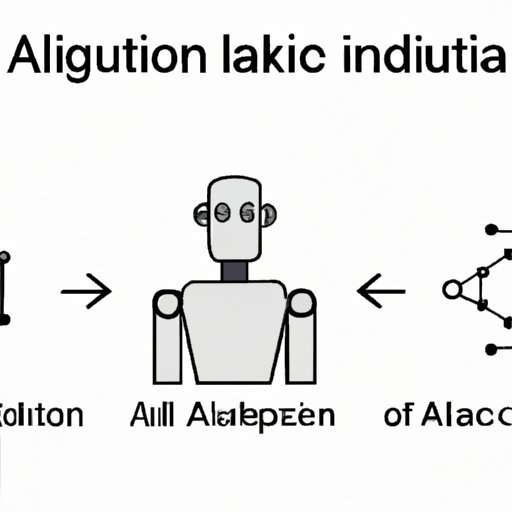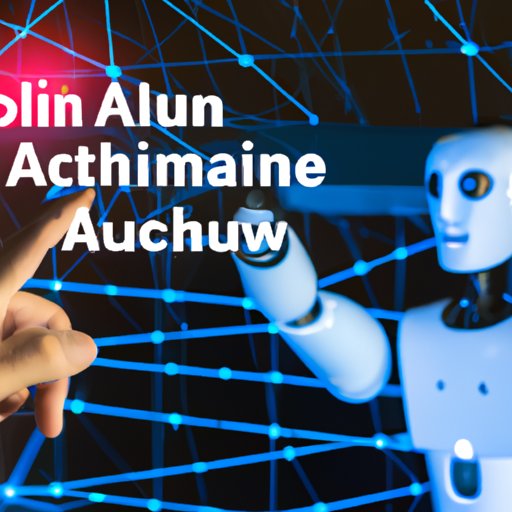Introduction
Artificial Intelligence (AI) has become an integral part of our society. From self-driving cars to voice assistants, AI algorithms are being used to automate tedious tasks and make life easier. But what exactly is an AI algorithm? This article will explore the definition of AI and algorithms, explain how they work, and discuss the types, benefits, challenges, and applications of AI algorithms.

Explaining Artificial Intelligence Algorithms: What They Are and How They Work
An AI algorithm is a set of instructions that allow a computer program to recognize patterns and solve problems. AI algorithms are based on a set of mathematical equations and rules that allow machines to learn from their environment and improve their performance over time. AI algorithms can be used for a variety of tasks, such as image recognition, natural language processing, data analysis, and more.
AI algorithms are divided into three main categories: supervised learning, unsupervised learning, and reinforcement learning. Supervised learning algorithms are fed labeled data and used to predict outcomes. Unsupervised learning algorithms are not given labeled data and are used to find patterns in unlabeled data. Reinforcement learning algorithms use reward systems to learn tasks and optimize their performance.

AI Algorithm Fundamentals: An Introduction for Beginners
In order to understand how AI algorithms work, it is important to understand the different components that make up an AI algorithm. These components include input data, output data, weights, biases, activation functions, and loss functions. Input data is the data that is fed into the algorithm, such as images or text. Output data is the result of the algorithm, such as a prediction about the input data. Weights and biases are variables used to adjust the algorithm’s parameters. Activation functions determine which neurons in the network should be activated. Loss functions measure the accuracy of the algorithm’s predictions.
When choosing an AI algorithm, there are several factors to consider. These include the type of problem you are trying to solve, the size of your dataset, the complexity of the task, and the computational resources available. It is important to choose an algorithm that is well suited to the task at hand to ensure optimal performance.
A Comprehensive Guide to Different Types of AI Algorithms
Supervised learning algorithms are the most widely used type of AI algorithms. These algorithms are trained on labeled data, which means that each data point has been labeled with the correct answer. Examples of supervised learning algorithms include support vector machines, decision trees, and logistic regression. Supervised learning algorithms are used for tasks such as classification, forecasting, and anomaly detection.
Unsupervised learning algorithms are used to identify patterns in unlabeled data. Examples of unsupervised learning algorithms include clustering algorithms, k-means clustering, and principal component analysis. Unsupervised learning algorithms are used for tasks such as market segmentation, customer segmentation, and feature extraction.
Reinforcement learning algorithms are used to learn tasks through trial and error. These algorithms use reward systems to optimize their performance. Examples of reinforcement learning algorithms include Q-learning and deep Q-networks. Reinforcement learning algorithms are used for tasks such as game playing and robotic control.
Understanding AI Algorithms: Benefits, Challenges and Applications
AI algorithms offer many benefits, including increased efficiency, improved accuracy, and reduced costs. AI algorithms can also be used to automate tedious tasks and reduce human error. However, AI algorithms also come with certain challenges, such as bias in the data, lack of interpretability, and privacy concerns.
AI algorithms have many applications, ranging from healthcare to finance to transportation. AI algorithms can be used for tasks such as image recognition, natural language processing, fraud detection, and financial trading. AI algorithms can also be used to improve customer service and enhance user experiences.

The Role of AI Algorithms in Automation and Robotics
AI algorithms are playing an increasingly important role in automation and robotics. AI algorithms can be used to control robots and automate complex tasks. For example, AI algorithms can be used to detect objects in the environment and navigate robots around obstacles. AI algorithms can also be used to control autonomous vehicles and enable them to make decisions in real time.
The future of AI algorithms in automation and robotics is bright. As AI algorithms become more sophisticated, they will be able to handle more complex tasks and enable robots to interact with humans in more natural ways. This could open up new possibilities for automation and robotics, such as collaborative robots and robots that can adapt to changing environments.
Conclusion
In conclusion, AI algorithms are powerful tools that can be used to automate complex tasks and improve accuracy. There are several types of AI algorithms, including supervised learning, unsupervised learning, and reinforcement learning algorithms. AI algorithms offer many benefits, but they also come with certain challenges. AI algorithms have many applications, ranging from healthcare to finance to transportation. Finally, AI algorithms are playing an increasingly important role in automation and robotics.
This article provided an overview of AI algorithms, including how they work, different components, types, benefits, challenges, applications, and role in automation and robotics. Understanding AI algorithms is essential for anyone interested in leveraging the power of AI for their business or organization.
(Note: Is this article not meeting your expectations? Do you have knowledge or insights to share? Unlock new opportunities and expand your reach by joining our authors team. Click Registration to join us and share your expertise with our readers.)
